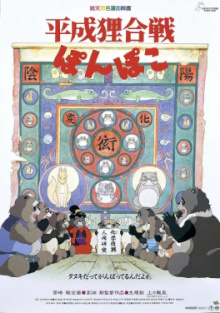Here’s one Studio Ghibli film my wife said she had difficulty getting into back in the day. And no wonder because rather than focusing on particular characters, it’s a larger story about the civilization of raccoon dogs having trouble adapting to the urban buildup of Japan. It actually goes so deeply into their culture and their magical abilities that I wondered how they are relevant, since after all this is all made up. It doesn’t hold back though, delighting in crude references to their balls, and explicitly shows both raccoon and human lives being lost as part of the conflict. Of course, this can’t be a story that has a happy ending but it strikes a heartfelt bittersweet note and that’s good enough.
The expansion of the suburbs around Tokyo leads to the destruction of the forests in the Tama Hills. The lack of living space and food cause the raccoon dogs, or tanuki, to fight amongst themselves. The matriarch admonishes them that infighting will only benefit the humans and urges them to stop breeding while they work on a way to stop the development. Calling upon their neglected magical abilities to transform themselves and create their illusions, they create diversions and sabotage the construction site, leading to some dead humans. But more workers arrive to replace the scared ones. One brash tanuki Gonta insists on all out war with humans. Some others including the young Shoukichi are more moderate. They send two emissaries to far off places in Japan to seek the assistance of elderly masters with legendary magical skills. Meanwhile the development project goes on and more and more of the forest is lost. When the masters finally arrive, they decide to combine their magical powers to stage a massive ghost parade to instill in the humans a new respect and fear of the supernatural.
Environmental themes are standard fare for Studio Ghibli. This one however directly pits an animal civilization against humanity. Not only are the tanuki intelligent, they have their own society and their own culture. There are a lot of references to the myths about the tanuki and other bits of Japanese folklore that I don’t get but are highly amusing. For example, the scrotum and balls of the tanuki seem to matter a great deal, so they are constantly transforming them into other objects or even using them as weapons. One would think that with their magical abilities, the tanuki would win in an all out war with the humans. But the film explains that they have been hunted by humans in the past and have learned the importance of hiding themselves away. Indeed, they prove to be too small, too nice and too easily distracted by food to seriously threaten humans for long. It’s cutesy and entertaining to see them enjoy watching a scavenged television, pine over McDonald’s food, or pull basically harmless pranks on the bewildered humans, but the Isao Takahata knows it can”t keep the audience’s sympathy if they are shown as being actually aggressive and effective at it.
The film goes so deep into the culture of the tanuki that I wondered how relevant this really is especially since it focuses on them as a whole instead of any particular characters. I do like the little ideas, like presenting Gonta’s group of violent fighters as eco-terrorists, how one group of tanuki who lack the magical ability to transform simply sail off to the next world, that the tanuki who disguise themselves as humans fuel themselves with energy drinks and so on. There’s a frisson of mystery and magic in imagining that there might still be tanuki and kitsune hiding among ordinary humans and of course it’s sad to think that those who lack magic and have no forests left to live in become the urban raccoons who scavenge in our garbage. Studio Ghibli never wants to end with an upset audience so it claims that the tanuki’s campaign helped to convince the public to set some land aside as parks though it is nowhere near enough for them.
As far as I can tell, this seems to be an overlooked Ghibli film, probably because it doesn’t really have any main characters. It works more like an exercise in worldbuilding with a narrator and it’s a solidly good film in that respect. I found it entertaining, imaginative and transgressively funny in a way that would never have been allowed in a Western cartoon. I suppose it makes you think about what has been lost as we level forests but we shouldn’t need to invent a fictional tanuki civilization to do that.
